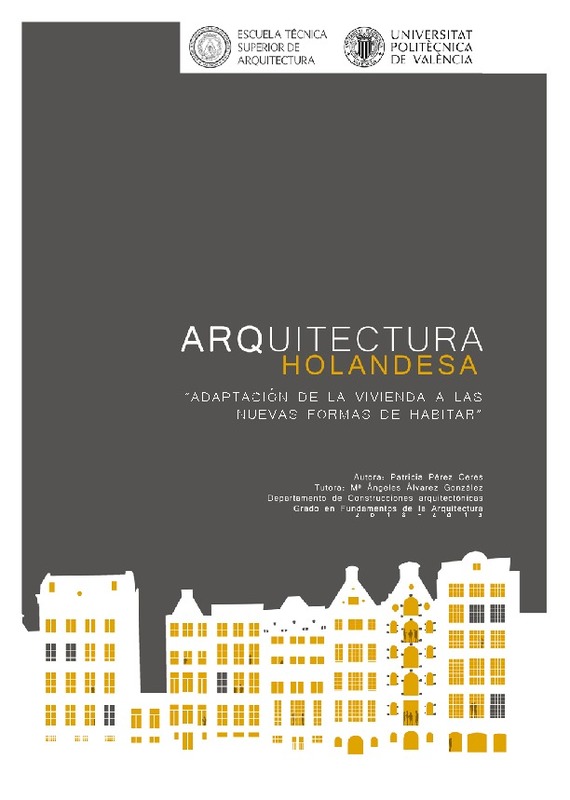JavaScript is disabled for your browser. Some features of this site may not work without it.
Buscar en RiuNet
Listar
Mi cuenta
Estadísticas
Ayuda RiuNet
Admin. UPV
ARQUITECTURA HOLANDESA. Adaptación de la vivienda a las nuevas formas de habitar
Mostrar el registro sencillo del ítem
Ficheros en el ítem
| dc.contributor.advisor | Álvarez González, Mª Angeles
|
es_ES |
| dc.contributor.author | Pérez Ceres, Patricia
|
es_ES |
| dc.coverage.spatial | east=5.291266; north=52.13263300000001; name=Holanda, Països Baixos | es_ES |
| dc.date.accessioned | 2020-01-17T08:14:10Z | |
| dc.date.available | 2020-01-17T08:14:10Z | |
| dc.date.created | 2019-09-19 | |
| dc.date.issued | 2020-01-17 | es_ES |
| dc.identifier.uri | http://hdl.handle.net/10251/134696 | |
| dc.description.abstract | [ES] La arquitectura holandesa está marcada por un factor importante, el agua. Desde hace años la población trata de luchar contra este elemento, en su instinto de supervivencia. La falta de terreno y alta densidad poblacional obligan a sus habitantes a adaptarse a este medio cambiante. Es por ese motivo principal por el que han desarrollado una arquitectura innovadora y de gran respeto hacia el medio que les rodea. En los Países Bajos se pueden observar todo tipo de viviendas, desde aquellas en medio terrestre caracterizadas por su flexibilidad y experimentación, hasta las viviendas en el agua. De este tipo, hay gran diversidad, adaptándose a las necesidades de cada espacio e individuo. Incluso se han empleado materiales reciclables en arquitectura, como el uso de contenedores como vivienda, por su conciencia ecológica, ya que nadie mejor que ellos son conscientes del periodo que les toca vivir, marcado por factores ambientales extremos, como es, el cambio climático. | es_ES |
| dc.description.abstract | [EN] Dutch architecture is marked by an important factor, water. For years people have been trying to fight against this element, in their survival instinct. The lack of land and high population density force its inhabitants to adapt to this changing environment. It is for this main reason that they have developed innovative architecture and great respect for the environment that surrounds them. In the Netherlands, all types of housing can be observed, from those in a terrestrial environment characterised by flexibility and experimentation, to housing in the water. Of this type, there is great diversity, adapting to the needs of each space and individual. Recyclable materials have even been used in architecture, such as the use of containers as housing, because of their ecological awareness, since no one better than them is aware of the period in which they live, marked by extreme environmental factors, such as climate change. | es_ES |
| dc.language | Español | es_ES |
| dc.publisher | Universitat Politècnica de València | es_ES |
| dc.rights | Reserva de todos los derechos | es_ES |
| dc.subject | Países Bajos | es_ES |
| dc.subject | Agua | es_ES |
| dc.subject | Contenedores | es_ES |
| dc.subject | Viviendas flotantes | es_ES |
| dc.subject | Vivienda | es_ES |
| dc.subject | Netherlands | es_ES |
| dc.subject | Containers | es_ES |
| dc.subject | Floating houses | es_ES |
| dc.subject | Water | es_ES |
| dc.subject | Dwelling | es_ES |
| dc.subject.classification | CONSTRUCCIONES ARQUITECTONICAS | es_ES |
| dc.subject.other | Grado en Fundamentos de la Arquitectura-Grau en Fonaments de l'Arquitectura | es_ES |
| dc.title | ARQUITECTURA HOLANDESA. Adaptación de la vivienda a las nuevas formas de habitar | es_ES |
| dc.type | Proyecto/Trabajo fin de carrera/grado | es_ES |
| dc.rights.accessRights | Abierto | es_ES |
| dc.description.bibliographicCitation | Pérez Ceres, P. (2019). ARQUITECTURA HOLANDESA. Adaptación de la vivienda a las nuevas formas de habitar. http://hdl.handle.net/10251/134696 | es_ES |
| dc.description.accrualMethod | TFGM | es_ES |
| dc.relation.pasarela | TFGM\100859 | es_ES |
Este ítem aparece en la(s) siguiente(s) colección(ones)
-
ETSA - Trabajos académicos [4687]
Escuela Técnica Superior de Arquitectura






